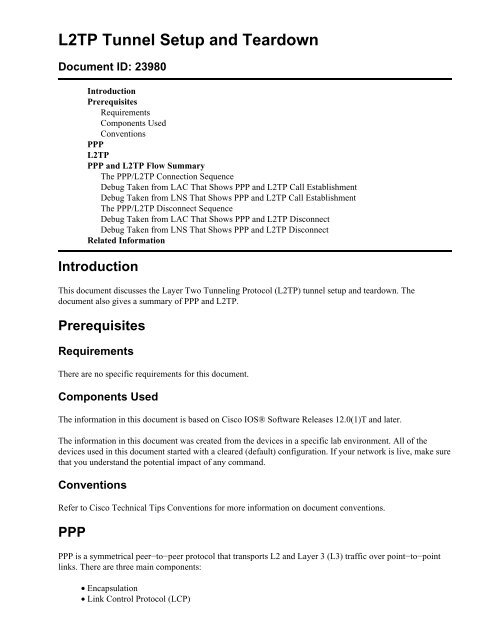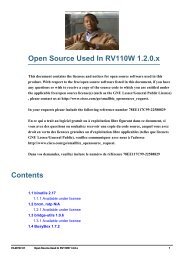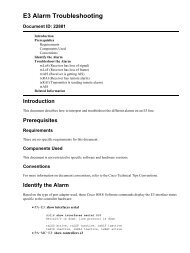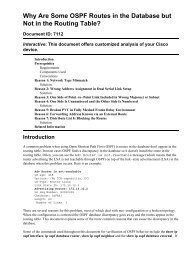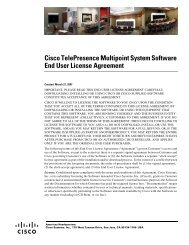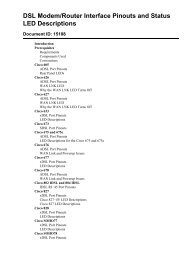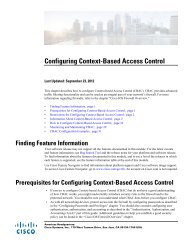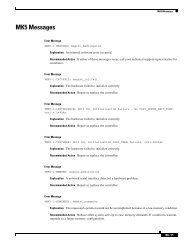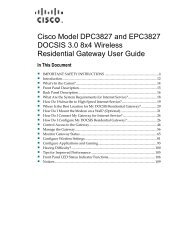Cisco - L2TP Tunnel Setup and Teardown
Cisco - L2TP Tunnel Setup and Teardown
Cisco - L2TP Tunnel Setup and Teardown
Create successful ePaper yourself
Turn your PDF publications into a flip-book with our unique Google optimized e-Paper software.
<strong>L2TP</strong> <strong>Tunnel</strong> <strong>Setup</strong> <strong>and</strong> <strong>Teardown</strong><br />
Document ID: 23980<br />
Introduction<br />
Prerequisites<br />
Requirements<br />
Components Used<br />
Conventions<br />
PPP<br />
<strong>L2TP</strong><br />
PPP <strong>and</strong> <strong>L2TP</strong> Flow Summary<br />
The PPP/<strong>L2TP</strong> Connection Sequence<br />
Debug Taken from LAC That Shows PPP <strong>and</strong> <strong>L2TP</strong> Call Establishment<br />
Debug Taken from LNS That Shows PPP <strong>and</strong> <strong>L2TP</strong> Call Establishment<br />
The PPP/<strong>L2TP</strong> Disconnect Sequence<br />
Debug Taken from LAC That Shows PPP <strong>and</strong> <strong>L2TP</strong> Disconnect<br />
Debug Taken from LNS That Shows PPP <strong>and</strong> <strong>L2TP</strong> Disconnect<br />
Related Information<br />
Introduction<br />
This document discusses the Layer Two <strong>Tunnel</strong>ing Protocol (<strong>L2TP</strong>) tunnel setup <strong>and</strong> teardown. The<br />
document also gives a summary of PPP <strong>and</strong> <strong>L2TP</strong>.<br />
Prerequisites<br />
Requirements<br />
There are no specific requirements for this document.<br />
Components Used<br />
The information in this document is based on <strong>Cisco</strong> IOS® Software Releases 12.0(1)T <strong>and</strong> later.<br />
The information in this document was created from the devices in a specific lab environment. All of the<br />
devices used in this document started with a cleared (default) configuration. If your network is live, make sure<br />
that you underst<strong>and</strong> the potential impact of any comm<strong>and</strong>.<br />
Conventions<br />
Refer to <strong>Cisco</strong> Technical Tips Conventions for more information on document conventions.<br />
PPP<br />
PPP is a symmetrical peer−to−peer protocol that transports L2 <strong>and</strong> Layer 3 (L3) traffic over point−to−point<br />
links. There are three main components:<br />
• Encapsulation<br />
• Link Control Protocol (LCP)
• Network Control Protocol (NCP)<br />
Datagrams are encapsulated in PPP. The LCP allows for the negotiation of configuration options to allow link<br />
establishment. NCPs are negotiated for each of the L3 protocols that runs on the link.<br />
During the life of a PPP session, the link goes though four distinct phases:<br />
<strong>L2TP</strong><br />
• Link establishingAs part of the link establishing phase, PPP uses an LCP function that must be<br />
completed <strong>and</strong> declared open before the link enters the authentication phase, if applicable, <strong>and</strong><br />
negotiates the opening of the network layer. LCP is also used to terminate the PPP link.<br />
• AuthenticationThe authentication phase is implementation−specific <strong>and</strong> is not a m<strong>and</strong>atory<br />
requirement for a move from LCP to NCP. If negotiated <strong>and</strong> agreed upon during the LCP phase, the<br />
remote peer must identify itself <strong>and</strong> pass the agreed authentication method before PPP moves to the<br />
network layer.<br />
• Network layerNCP negotiation ensures that both peers agree on the characteristics of the L3<br />
protocol. In the case of IP, the control protocol is called IP Control Protocol (IPCP). In addition to the<br />
negotiation between peers, there is also an element of assignment. This is common with Microsoft<br />
Windows−type remote−access clients who have no allocated IP address <strong>and</strong> rely on the service<br />
provider to allocate the IP address upon connection.<br />
• Link terminationThe link termination phase can be entered at any time during the life cycle of the<br />
call. LCP is used to deliver the termination request.<br />
<strong>L2TP</strong> extends the point−to−point nature of PPP. <strong>L2TP</strong> provides an encapsulation method for the transmit of<br />
tunneled PPP frames, which allows the PPP endpoints to be tunneled over a packet−switched network. <strong>L2TP</strong><br />
is most commonly deployed in remote−access−type scenarios that use the Internet to offer intranet−type<br />
services. The concept is that of a Virtual Private Network (VPN).<br />
The two primary physical elements of <strong>L2TP</strong> are the <strong>L2TP</strong> Access Concentrator (LAC) <strong>and</strong> the <strong>L2TP</strong> Network<br />
Server (LNS):<br />
• LACThe LAC is a peer to the LNS that acts as one side of the tunnel endpoint. The LAC terminates<br />
the remote PPP connection <strong>and</strong> sits between the remote <strong>and</strong> the LNS. Packets are forwarded to <strong>and</strong><br />
from the remote connection over the PPP connection. Packets to <strong>and</strong> from the LNS are forwarded<br />
over the <strong>L2TP</strong> tunnel.<br />
• LNSThe LNS is a peer to the LAC that acts as one side of the tunnel endpoint. The LNS is the<br />
termination point for the LAC PPP tunneled sessions. This is used to aggregate the multiple<br />
LAC−tunneled PPP sessions <strong>and</strong> ingress into the private network.<br />
There are two different message types that <strong>L2TP</strong> uses:<br />
• Control messages<strong>L2TP</strong> passes control <strong>and</strong> data messages over separate control <strong>and</strong> data channels.<br />
The in−b<strong>and</strong> control channel passes sequenced control connection management, call management,<br />
error reporting, <strong>and</strong> session control messages. Initiation of the control connection is not specific to<br />
either the LAC or the LNS but, rather, the tunnel originator <strong>and</strong> receiver that has relevance in the<br />
control connection establishment. A shared−secret challenge authentication method is used between<br />
the tunnel endpoints.<br />
• Data messagesData messages are used to encapsulate the PPP frames that are sent into the <strong>L2TP</strong><br />
tunnel.<br />
<strong>L2TP</strong> uses the registered User Datagram Protocol (UDP) port 1701, <strong>and</strong> the whole <strong>L2TP</strong> packet is<br />
encapsulated within the UDP datagram. As per normal UDP operation, the tunnel initiator selects an available
UDP port <strong>and</strong> sends port number 1701 to the UDP destination. In the reply, the destination port number is the<br />
same as the source port number that is used in the incoming UDP header. The source port is set on the basis of<br />
any free port that is found. After the source <strong>and</strong> destination ports are established, the ports must remain the<br />
same for the duration of the tunnel. In <strong>Cisco</strong> IOS Software, the source <strong>and</strong> destination port numbers are<br />
always set to UDP port number 1701.<br />
Note: Layer 2 Forwarding (L2F) Protocol <strong>and</strong> <strong>L2TP</strong> share the same UDP port number. The Version field in<br />
the header enables you to discriminate between the two protocols. A value of 1 indicates L2F, <strong>and</strong> a value of 2<br />
indicates <strong>L2TP</strong>.<br />
PPP <strong>and</strong> <strong>L2TP</strong> Flow Summary<br />
Establishment of the control connection <strong>and</strong> session must occur before PPP frames can be forwarded through<br />
the tunnel.<br />
After successful establishment of the control channel, sessions are created for each PPP connection. Session<br />
establishment is directional, in relation to the LAC <strong>and</strong> LNS. For incoming calls, the LAC requests the LNS to<br />
accept the session. For outgoing calls, the LNS asks the LAC to accept the session.<br />
The PPP/<strong>L2TP</strong> Connection Sequence section of this document details the PPP <strong>and</strong> <strong>L2TP</strong> call setup when a<br />
remote−access user places a call into the LAC. This example uses the dialed number identification service<br />
(DNIS) in order to initiate the <strong>L2TP</strong> tunnel, although you can also use the domain name for this purpose. The<br />
sequence shows the start of the PPP session from a SOHO 2500 router, the LCP negotiation between the<br />
remote−access user <strong>and</strong> LAC, <strong>and</strong> the partial authentication. The LAC then proceeds to establish the <strong>L2TP</strong><br />
tunnel <strong>and</strong> session within the tunnel. A session is established for each PPP connection between the LAC <strong>and</strong><br />
LNS. <strong>L2TP</strong> uses the peer tunnel <strong>and</strong> session identifiers in all outgoing messages in order to multiplex <strong>and</strong><br />
demultiplex PPP connections. These identifiers are assigned <strong>and</strong> exchanged during the respective control<br />
connection <strong>and</strong> session establishment phases. The tunnel <strong>and</strong> session IDs have local significance only. The<br />
tunnel endpoints have different identifiers for the same tunnel <strong>and</strong> session.<br />
Note: The value 0 has unique significance <strong>and</strong> is only used when the tunnel <strong>and</strong> session identifier have yet to<br />
be assigned.<br />
After establishment of the tunnel, the PPP authentication process completes between the remote−access user<br />
<strong>and</strong> the LNS. The LAC continues to receive PPP frames. The link framing <strong>and</strong> cyclic redundancy check<br />
(CRC) are removed, encapsulated into LT2P, <strong>and</strong> forwarded into the tunnel to the LNS. There, the <strong>L2TP</strong><br />
packet is received <strong>and</strong> treated as if it were terminated on a local PPP interface. The negotiation of PPP NCP<br />
occurs, <strong>and</strong> then IPCP is declared open. The connection is complete.<br />
The PPP/<strong>L2TP</strong> Connection Sequence<br />
This is the connection sequence of events:<br />
1. The remote user initiates a PPP connection. The LAC accepts the connection. A PPP link is<br />
established.<br />
2. LCP is negotiated between the remote user <strong>and</strong> LAC. The LAC issues a Challenge H<strong>and</strong>shake<br />
Authentication Protocol (CHAP) challenge in order to perform a partial authentication of the remote<br />
user. The reply is sent to the LNS during session establishment. The reply is sent as attribute−value<br />
pair (AVP) 33 proxy authentication response in the Incoming−Call−Connected (ICCN).<br />
3. The DNIS is used to determine whether the user is a virtual private dial−up network (VPDN) client.<br />
4. Because there is no existing tunnel for the dialed number (614629), creation of a new tunnel is<br />
necessary. RADIUS is queried <strong>and</strong> the tunnel information is downloaded to the LAC.<br />
5. The control connection is started. The tunnel is in an IDLE state:
♦ The tunnel initiator (in this case, the LAC) sends a Start−Control−Connection−Request<br />
(SCCRQ) to the LNS. The SCCRQ contains an AVP 11 challenge, which indicates that the<br />
LAC wants to authenticate the tunnel with use of a CHAP−style authentication. The same<br />
secret is known to both tunnel endpoints. The tunnel is now in a WAIT−CTL−REPLY state.<br />
♦ The LNS can bring up the tunnel, so the LNS replies with a Start−Control−Connection−Reply<br />
(SCCRP). The SCCRP contains an AVP 11 challenge <strong>and</strong> an AVP 13 challenge response in<br />
reply to the SCCRQ. The tunnel is now in a WAIT−CTL−REPLY state.<br />
♦ The LAC responds with a Start−Control−Connection−Connected (SCCCN) message. The<br />
SCCCN contains an AVP 13 in reply to the SCCRP. The tunnel is now in an Established<br />
state.<br />
♦ The LNS sends a Zero−Length Body (ZLB) message to the LAC. The ZLB message is a<br />
sequenced acknowledgement. The tunnel is now in an Established state.<br />
6. The tunnel authentication is now complete <strong>and</strong> the tunnel is established. The session is now in an<br />
IDLE state.<br />
7. Now that the tunnel exists, a three−way exchange for session establishment within the tunnel is<br />
performed:<br />
♦ The LAC sends an Incoming−Call−Request (ICRQ) with the parameter information for the<br />
session. The session is now in a Wait Reply state.<br />
♦ The LNS sends an Incoming−Call−Reply (ICRP) that contains the session ID. The session is<br />
now in a Wait Connect state.<br />
♦ The LAC sends an ICCN <strong>and</strong> provides the LNS with additional information for the answered<br />
call. This information includes the LCP information from the negotiation that the LAC <strong>and</strong><br />
remote user performed. The session is now in an Established state.<br />
♦ The LNS sends a ZLB message, which is a sequenced acknowledgement, to the LAC. The<br />
session is now in an Established state.<br />
8. After establishment of the session, a virtual access interface is created on the LNS. The LCP<br />
configuration information that was delivered in the ICCN is forced onto the virtual access interface<br />
PPP stack. This information includes the partial authentication information.<br />
9. The LNS generates an authentication challenge. The proxy authentication response AVP 33, which<br />
was delivered in the ICCN, is replayed.<br />
10. Normal authentication, authorization, <strong>and</strong> accounting (AAA) or PPP authentication <strong>and</strong> authorization<br />
takes place.<br />
11. A RADIUS Access−Request is sent for per−user authentication <strong>and</strong> authorization.<br />
12. A RADIUS Access−Accept is received.<br />
Note: RADIUS has been configured to allow the IP address that the remote user has offered in the<br />
incoming IPCP Configure−Request.<br />
13. A CHAP success message is sent to the remote user.<br />
14. PPP IPCP negotiation completes <strong>and</strong> is declared OPEN. A host route is installed to the remote<br />
interface. The remote user is now connected, <strong>and</strong> traffic flow can commence.<br />
PPP <strong>and</strong> <strong>L2TP</strong> Connection Call Flow
Debug Taken from LAC That Shows PPP <strong>and</strong> <strong>L2TP</strong> Call Establishment<br />
Jan 1 00:04:10.235: %LINK−3−UPDOWN: Interface Serial0:0,<br />
changed state to up<br />
Jan 1 00:04:10.455: Se0:0 PPP: Treating connection as a callin<br />
Jan 1 00:04:10.455: Se0:0 PPP: Phase is ESTABLISHING,<br />
Passive Open [0 sess, 0 load]<br />
Jan 1 00:04:10.455: Se0:0 CHAP: Using alternate hostname 5300−1<br />
Jan 1 00:04:10.455: Se0:0 LCP: State is Listen<br />
Jan 1 00:04:10.455: Se0:0 LCP: I CONFREQ [Listen] id 118 len 10<br />
Jan 1 00:04:10.455: Se0:0 LCP: MagicNumber 0x6EE4E865 (0x05066EE4E865)<br />
Jan 1 00:04:10.455: Se0:0 CHAP: Using alternate hostname 5300−1<br />
Jan 1 00:04:10.455: Se0:0 LCP: O CONFREQ [Listen] id 11 len 28<br />
Jan 1 00:04:10.455: Se0:0 LCP: AuthProto CHAP (0x0305C22305)<br />
Jan 1 00:04:10.455: Se0:0 LCP: MagicNumber 0x109D08F2 (0x0506109D08F2)<br />
Jan 1 00:04:10.455: Se0:0 LCP: MRRU 1524 (0x110405F4)<br />
Jan 1 00:04:10.455: Se0:0 LCP: EndpointDisc 1 Local (0x130901353330302D31)<br />
Jan 1 00:04:10.455: Se0:0 LCP: O CONFACK [Listen] id 118 len 10<br />
Jan 1 00:04:10.455: Se0:0 LCP: MagicNumber 0x6EE4E865 (0x05066EE4E865)<br />
Jan 1 00:04:10.495: Se0:0 LCP: I CONFREJ [ACKsent] id 11 len 17<br />
Jan 1 00:04:10.495: Se0:0 LCP: MRRU 1524 (0x110405F4)<br />
Jan 1 00:04:10.495: Se0:0 LCP: EndpointDisc 1 Local (0x130901353330302D31)<br />
Jan 1 00:04:10.495: Se0:0 LCP: O CONFREQ [ACKsent] id 12 len 15<br />
Jan 1 00:04:10.495: Se0:0 LCP: AuthProto CHAP (0x0305C22305)<br />
Jan 1 00:04:10.495: Se0:0 LCP: MagicNumber 0x109D08F2 (0x0506109D08F2)<br />
Jan 1 00:04:10.527: Se0:0 LCP: I CONFACK [ACKsent] id 12 len 15<br />
Jan 1 00:04:10.527: Se0:0 LCP: AuthProto CHAP (0x0305C22305)<br />
Jan 1 00:04:10.527: Se0:0 LCP: MagicNumber 0x109D08F2 (0x0506109D08F2)<br />
Jan 1 00:04:10.527: Se0:0 LCP: State is Open<br />
Jan 1 00:04:10.527: Se0:0 PPP: Phase is AUTHENTICATING,<br />
by this end [0 sess, 0 load]<br />
Jan 1 00:04:10.527: Se0:0 CHAP: Using alternate hostname 5300−1<br />
Jan 1 00:04:10.527: Se0:0 CHAP: O CHALLENGE id 6 len 27 from "5300−1"<br />
Jan 1 00:04:10.555: Se0:0 CHAP: I RESPONSE id 6 len 27 from "2500−1"<br />
Jan 1 00:04:10.555: Se0:0 PPP: Phase is FORWARDING [0 sess, 0 load]
Jan 1 00:04:10.555: Se0:0 VPDN: Got DNIS string 614629<br />
Jan 1 00:04:10.555: Se0:0 VPDN: Looking for tunnel −− dnis:614629 −−<br />
Jan 1 00:04:10.555: Serial0:0 AAA/AUTHOR/VPDN (1692520761): Port='Serial0:0'<br />
list='default' service=NET<br />
Jan 1 00:04:10.555: AAA/AUTHOR/VPDN: Serial0:0 (1692520761) user='dnis:614629'<br />
Jan 1 00:04:10.555: Serial0:0 AAA/AUTHOR/VPDN (1692520761): send AV service=ppp<br />
Jan 1 00:04:10.555: Serial0:0 AAA/AUTHOR/VPDN (1692520761): send AV protocol=vpdn<br />
Jan 1 00:04:10.555: Serial0:0 AAA/AUTHOR/VPDN (1692520761): found list "default"<br />
Jan 1 00:04:10.555: Serial0:0 AAA/AUTHOR/VPDN (1692520761): Method=NSA_LAB (radius)<br />
Jan 1 00:04:10.559: RADIUS: Initial Transmit Serial0:0 id 18 10.51.6.3:1645,<br />
Access−Request, len 112<br />
Jan 1 00:04:10.559:<br />
Attribute 4 6 0A330644<br />
Jan 1 00:04:10.559: Attribute 5 6 00000000<br />
Jan 1 00:04:10.559:<br />
Attribute 26 17 00000009020B5365<br />
Jan 1 00:04:10.559: Attribute 61 6 00000002<br />
Jan 1 00:04:10.559:<br />
Attribute 1 13 646E6973<br />
Jan 1 00:04:10.559: Attribute 30 8 36313436<br />
Jan 1 00:04:10.559: Attribute 31 12 32303835<br />
Jan 1 00:04:10.559:<br />
Attribute 2 18 D0A81832<br />
Jan 1 00:04:10.559: Attribute 6 6 00000005<br />
Jan 1 00:04:10.559: RADIUS: Received from id 18 10.51.6.3:1645,<br />
Access−Accept, len 156<br />
Jan 1 00:04:10.559: Attribute 6 6 00000005<br />
Jan 1 00:04:10.559: Attribute 26 29 0000000901177670<br />
Jan 1 00:04:10.559: Attribute 26 26 0000000901147670<br />
Jan 1 00:04:10.559:<br />
Attribute 26 36 00000009011E7670<br />
Jan 1 00:04:10.559: Attribute 26 39 0000000901217670<br />
Jan 1 00:04:10.563: RADIUS: saved authorization data<br />
for user 626A0C10 at 62258960<br />
Jan 1 00:04:10.563: RADIUS: cisco AVPair "vpdn:tunnel−type=l2tp"<br />
Jan 1 00:04:10.563: RADIUS: cisco AVPair "vpdn:tunnel−id=hgw"<br />
Jan 1 00:04:10.563: RADIUS: cisco AVPair "vpdn:ip−addresses=10.51.6.82"<br />
Jan 1 00:04:10.563: RADIUS: cisco AVPair "vpdn:l2tp−tunnel−password=hello"<br />
Jan 1 00:04:10.563: AAA/AUTHOR (1692520761):<br />
Post authorization status = PASS_ADD<br />
Jan 1 00:04:10.563: AAA/AUTHOR/VPDN: Processing AV service=ppp<br />
Jan 1 00:04:10.563: AAA/AUTHOR/VPDN: Processing AV protocol=vpdn<br />
Jan 1 00:04:10.563: AAA/AUTHOR/VPDN: Processing AV tunnel−type=l2tp<br />
Jan 1 00:04:10.563: AAA/AUTHOR/VPDN: Processing AV tunnel−id=hgw<br />
Jan 1 00:04:10.563: AAA/AUTHOR/VPDN: Processing AV ip−addresses=10.51.6.82<br />
Jan 1 00:04:10.563: AAA/AUTHOR/VPDN: Processing AV l2tp−tunnel−password=hello<br />
Jan 1 00:04:10.563: Se0:0 VPDN/RPMS/: Got tunnel info for dnis:614629<br />
Jan 1 00:04:10.563: Se0:0 VPDN/RPMS/: LAC hgw<br />
Jan 1 00:04:10.563: Se0:0 VPDN/RPMS/: l2tp−busy−disconnect yes<br />
Jan 1 00:04:10.563: Se0:0 VPDN/RPMS/: l2tp−tunnel−password xxxxxx<br />
Jan 1 00:04:10.563: Se0:0 VPDN/RPMS/: IP 10.51.6.82<br />
Jan 1 00:04:10.563: Se0:0 VPDN/: curlvl 1 Address 0: 10.51.6.82,<br />
priority 1<br />
Jan 1 00:04:10.563: Se0:0 VPDN/: Select non−active address 10.51.6.82,<br />
priority 1<br />
Jan 1 00:04:10.567: Tnl 17688 <strong>L2TP</strong>: SM State idle<br />
Jan 1 00:04:10.567: Tnl 17688 <strong>L2TP</strong>: O SCCRQ<br />
Jan 1 00:04:10.567: Tnl 17688 <strong>L2TP</strong>: O SCCRQ, flg TLS, ver 2,<br />
len 128, tnl 0, cl 0, ns 0, nr 0<br />
C8 02 00 80 00 00 00 00 00 00 00 00 80 08 00 00<br />
00 00 00 01 80 08 00 00 00 02 01 00 80 0A 00 00<br />
00 03 00 00 00 03 80 0A 00 00 00 04 00 00 00 ...<br />
Jan 1 00:04:10.567: Tnl 17688 <strong>L2TP</strong>: <strong>Tunnel</strong> state change from idle<br />
to wait−ctl−reply<br />
Jan 1 00:04:10.567: Tnl 17688 <strong>L2TP</strong>: SM State wait−ctl−reply<br />
Jan 1 00:04:10.567: Se0:0 VPDN: Find LNS process created<br />
Jan 1 00:04:10.567: Se0:0 VPDN: Forward to address 10.51.6.82<br />
Jan 1 00:04:10.567: Se0:0 VPDN: Pending<br />
Jan 1 00:04:10.567: Se0:0 VPDN: Process created<br />
Jan 1 00:04:10.655: Tnl 17688 <strong>L2TP</strong>: Parse AVP 0, len 8, flag 0x8000 (M)<br />
Jan 1 00:04:10.655: Tnl 17688 <strong>L2TP</strong>: Parse SCCRP
Jan 1 00:04:10.655: Tnl 17688 <strong>L2TP</strong>: Parse AVP 2, len 8, flag 0x8000 (M)<br />
Jan 1 00:04:10.655: Tnl 17688 <strong>L2TP</strong>: Protocol Ver 256<br />
Jan 1 00:04:10.655: Tnl 17688 <strong>L2TP</strong>: Parse AVP 3, len 10, flag 0x8000 (M)<br />
Jan 1 00:04:10.655: Tnl 17688 <strong>L2TP</strong>: Framing Cap 0x3<br />
Jan 1 00:04:10.655: Tnl 17688 <strong>L2TP</strong>: Parse AVP 4, len 10, flag 0x8000 (M)<br />
Jan 1 00:04:10.655: Tnl 17688 <strong>L2TP</strong>: Bearer Cap 0x3<br />
Jan 1 00:04:10.659: Tnl 17688 <strong>L2TP</strong>: Parse AVP 6, len 8, flag 0x0<br />
Jan 1 00:04:10.659: Tnl 17688 <strong>L2TP</strong>: Firmware Ver 0x1120<br />
Jan 1 00:04:10.659: Tnl 17688 <strong>L2TP</strong>: Parse AVP 7, len 13, flag 0x8000 (M)<br />
Jan 1 00:04:10.659: Tnl 17688 <strong>L2TP</strong>: Hostname l2tp−gw<br />
Jan 1 00:04:10.659: Tnl 17688 <strong>L2TP</strong>: Parse AVP 8, len 25, flag 0x0<br />
Jan 1 00:04:10.659: Tnl 17688 <strong>L2TP</strong>: Vendor Name <strong>Cisco</strong> Systems, Inc.<br />
Jan 1 00:04:10.659: Tnl 17688 <strong>L2TP</strong>: Parse AVP 9, len 8, flag 0x8000 (M)<br />
Jan 1 00:04:10.659: Tnl 17688 <strong>L2TP</strong>: Assigned <strong>Tunnel</strong> ID 55270<br />
Jan 1 00:04:10.659: Tnl 17688 <strong>L2TP</strong>: Parse AVP 10, len 8, flag 0x8000 (M)<br />
Jan 1 00:04:10.659: Tnl 17688 <strong>L2TP</strong>: Rx Window Size 300<br />
Jan 1 00:04:10.659: Tnl 17688 <strong>L2TP</strong>: Parse AVP 11, len 22, flag 0x8000 (M)<br />
Jan 1 00:04:10.659: Tnl 17688 <strong>L2TP</strong>: Chlng 98B296C28429E7ADC767237A45F31040<br />
Jan 1 00:04:10.659: Tnl 17688 <strong>L2TP</strong>: Parse AVP 13, len 22, flag 0x8000 (M)<br />
Jan 1 00:04:10.659: Tnl 17688 <strong>L2TP</strong>: Chlng Resp 7C358F7A7BA21957C07801195DCADFA6<br />
Jan 1 00:04:10.659: Tnl 17688 <strong>L2TP</strong>: No missing AVPs in SCCRP<br />
Jan 1 00:04:10.659: Tnl 17688 <strong>L2TP</strong>: I SCCRP, flg TLS, ver 2,<br />
len 154, tnl 17688, cl 0, ns 0, nr 1<br />
C8 02 00 9A 45 18 00 00 00 00 00 01 80 08 00 00<br />
00 00 00 02 80 08 00 00 00 02 01 00 80 0A 00 00<br />
00 03 00 00 00 03 80 0A 00 00 00 04 00 00 00 ...<br />
Jan 1 00:04:10.659: Tnl 17688 <strong>L2TP</strong>: I SCCRP from l2tp−gw<br />
Jan 1 00:04:10.659: Tnl 17688 <strong>L2TP</strong>: Got a challenge from remote peer,<br />
l2tp−gw<br />
Jan 1 00:04:10.659: Tnl 17688 <strong>L2TP</strong>: Got a response from remote peer, l2tp−gw<br />
Jan 1 00:04:10.659: Tnl 17688 <strong>L2TP</strong>: <strong>Tunnel</strong> Authentication success<br />
Jan 1 00:04:10.659: Tnl 17688 <strong>L2TP</strong>: <strong>Tunnel</strong> state change from wait−ctl−reply<br />
to established<br />
Jan 1 00:04:10.663: Tnl 17688 <strong>L2TP</strong>: O SCCCN to l2tp−gw tnlid 55270<br />
Jan 1 00:04:10.663: Tnl 17688 <strong>L2TP</strong>: O SCCCN, flg TLS, ver 2, len 42,<br />
tnl 55270, cl 0, ns 1, nr 1<br />
C8 02 00 2A D7 E6 00 00 00 01 00 01 80 08 00 00<br />
00 00 00 03 80 16 00 00 00 0D 96 39 53 18 41 AC<br />
22 E3 10 3E 20 8E F7 D9 09 89<br />
Jan 1 00:04:10.663: Tnl 17688 <strong>L2TP</strong>: SM State established<br />
Jan 1 00:04:10.663: Tnl/Cl 17688/7 <strong>L2TP</strong>: Session FS enabled<br />
Jan 1 00:04:10.663: Tnl/Cl 17688/7 <strong>L2TP</strong>: Session state change from idle<br />
to wait−for−tunnel<br />
Jan 1 00:04:10.663: Se0:0 Tnl/Cl 17688/7 <strong>L2TP</strong>: Create session<br />
Jan 1 00:04:10.663: Tnl 17688 <strong>L2TP</strong>: SM State established<br />
Jan 1 00:04:10.663: Se0:0 Tnl/Cl 17688/7 <strong>L2TP</strong>: O ICRQ to l2tp−gw 55270/0<br />
Jan 1 00:04:10.663: Se0:0 Tnl/Cl 17688/7 <strong>L2TP</strong>: O ICRQ, flg TLS,<br />
ver 2, len 91, tnl 55270, cl 0, ns 2, nr 1<br />
C8 02 00 5B D7 E6 00 00 00 02 00 01 80 08 00 00<br />
00 00 00 0A 80 08 00 00 00 0E 00 07 80 0A 00 00<br />
00 0F D1 14 C7 C5 80 0A 00 00 00 12 00 00 00 ...<br />
Jan 1 00:04:10.667: Se0:0 Tnl/Cl 17688/7 <strong>L2TP</strong>: Session state change from<br />
wait−for−tunnel to wait−reply<br />
Jan 1 00:04:10.703: Tnl 17688 <strong>L2TP</strong>: I ZLB ctrl ack, flg TLS, ver 2,<br />
len 12, tnl 17688, cl 0, ns 1, nr 2<br />
Jan 1 00:04:10.795: Se0:0 Tnl/Cl 17688/7 <strong>L2TP</strong>: Parse AVP 0, len 8,<br />
flag 0x8000 (M)<br />
Jan 1 00:04:10.795: Se0:0 Tnl/Cl 17688/7 <strong>L2TP</strong>: Parse ICRP<br />
Jan 1 00:04:10.795: Se0:0 Tnl/Cl 17688/7 <strong>L2TP</strong>: Parse AVP 14, len 8,<br />
flag 0x8000 (M)<br />
Jan 1 00:04:10.795: Se0:0 Tnl/Cl 17688/7 <strong>L2TP</strong>: Assigned Call ID 45<br />
Jan 1 00:04:10.795: Se0:0 Tnl/Cl 17688/7 <strong>L2TP</strong>: No missing AVPs in ICRP<br />
Jan 1 00:04:10.795: Se0:0 Tnl/Cl 17688/7 <strong>L2TP</strong>: I ICRP, flg TLS,<br />
ver 2, len 28, tnl 17688, cl 7, ns 1, nr 3<br />
C8 02 00 1C 45 18 00 07 00 01 00 03 80 08 00 00<br />
00 00 00 0B 80 08 00 00 00 0E 00 2D
Jan 1 00:04:10.795: Se0:0 Tnl/Cl 17688/7 <strong>L2TP</strong>: O ICCN to l2tp−gw 55270/45<br />
Jan 1 00:04:10.795: Se0:0 Tnl/Cl 17688/7 <strong>L2TP</strong>: O ICCN, flg TLS, ver 2,<br />
len 151, tnl 55270, cl 45, ns 3, nr 2<br />
C8 02 00 97 D7 E6 00 2D 00 03 00 02 80 08 00 00<br />
00 00 00 0C 80 0A 00 00 00 18 00 00 FA 00 00 0A<br />
00 00 00 26 00 00 FA 00 80 0A 00 00 00 13 00 ...<br />
Jan 1 00:04:10.795: Se0:0 Tnl/Cl 17688/7 <strong>L2TP</strong>: Session state change<br />
from wait−reply to established<br />
Jan 1 00:04:10.899: Tnl 17688 <strong>L2TP</strong>: I ZLB ctrl ack, flg TLS, ver 2,<br />
len 12, tnl 17688, cl 0, ns 2, nr 4<br />
Jan 1 00:04:11.667: %LINEPROTO−5−UPDOWN: Line protocol on Interface Serial0:0,<br />
changed state to up<br />
Jan 1 00:04:16.239: %ISDN−6−CONNECT: Interface Serial0:0 is now connected to<br />
2085730592 2500−1<br />
Debug Taken from LNS That Shows PPP <strong>and</strong> <strong>L2TP</strong> Call Establishment<br />
Jan 1 00:04:10.916: L2X: Parse AVP 0, len 8, flag 0x0x8000 (M)<br />
Jan 1 00:04:10.920: L2X: Parse SCCRQ<br />
Jan 1 00:04:10.920: L2X: Parse AVP 2, len 8, flag 0x0x8000 (M)<br />
Jan 1 00:04:10.924: L2X: Protocol Ver 256<br />
Jan 1 00:04:10.924: L2X: Parse AVP 3, len 10, flag 0x0x8000 (M)<br />
Jan 1 00:04:10.928: L2X: Framing Cap 0x0x3<br />
Jan 1 00:04:10.928: L2X: Parse AVP 4, len 10, flag 0x0x8000 (M)<br />
Jan 1 00:04:10.932: L2X: Bearer Cap 0x0x3<br />
Jan 1 00:04:10.932: L2X: Parse AVP 6, len 8, flag 0x0x0<br />
Jan 1 00:04:10.936: L2X: Firmware Ver 0x0x1130<br />
Jan 1 00:04:10.936: L2X: Parse AVP 7, len 9, flag 0x0x8000 (M)<br />
Jan 1 00:04:10.940: L2X: Hostname hgw<br />
Jan 1 00:04:10.940: L2X: Parse AVP 8, len 25, flag 0x0x0<br />
Jan 1 00:04:10.944: L2X: Vendor Name <strong>Cisco</strong> Systems, Inc.<br />
Jan 1 00:04:10.948: L2X: Parse AVP 9, len 8, flag 0x0x8000 (M)<br />
Jan 1 00:04:10.952: L2X: Assigned <strong>Tunnel</strong> ID 17688<br />
Jan 1 00:04:10.952: L2X: Parse AVP 10, len 8, flag 0x0x8000 (M)<br />
Jan 1 00:04:10.956: L2X: Rx Window Size 800<br />
Jan 1 00:04:10.956: L2X: Parse AVP 11, len 22, flag 0x0x8000 (M)<br />
Jan 1 00:04:10.960: L2X: Chlng 545A2343FBE20EA08BCA7B56E4A7D29E<br />
Jan 1 00:04:10.964: L2X: No missing AVPs in SCCRQ<br />
Jan 1 00:04:10.968: L2X: I SCCRQ, flg TLS, ver 2, len 128,<br />
tnl 0, cl 0, ns 0, nr 0 contiguous pak, size 128<br />
C8 02 00 80 00 00 00 00 00 00 00 00 80 08 00 00<br />
00 00 00 01 80 08 00 00 00 02 01 00 80 0A 00 00<br />
00 03 00 00 00 03 80 0A 00 00 00 04 00 00 00 ...<br />
Jan 1 00:04:10.975: <strong>L2TP</strong>: I SCCRQ from hgw tnl 17688<br />
Jan 1 00:04:10.983: Tnl 55270 <strong>L2TP</strong>: Got a challenge in SCCRQ, hgw<br />
Jan 1 00:04:10.983: Tnl 55270 <strong>L2TP</strong>: New tunnel created for remote hgw,<br />
address 10.51.6.68<br />
Jan 1 00:04:10.987: Tnl 55270 <strong>L2TP</strong>: O SCCRP to hgw tnlid 17688<br />
Jan 1 00:04:10.991: Tnl 55270 <strong>L2TP</strong>: O SCCRP, flg TLS, ver 2,<br />
len 154, tnl 17688, cl 0, ns 0, nr 1<br />
Jan 1 00:04:10.999: contiguous buffer, size 154<br />
C8 02 00 9A 45 18 00 00 00 00 00 01 80 08 00 00<br />
00 00 00 02 80 08 00 00 00 02 01 00 80 0A 00 00<br />
00 03 00 00 00 03 80 0A 00 00 00 04 00 00 00 ...<br />
Jan 1 00:04:11.003: Tnl 55270 <strong>L2TP</strong>: <strong>Tunnel</strong> state change from idle<br />
to wait−ctl−reply<br />
Jan 1 00:04:11.019: Tnl 55270 <strong>L2TP</strong>: Parse AVP 0, len 8, flag 0x0x8000 (M)<br />
Jan 1 00:04:11.019: Tnl 55270 <strong>L2TP</strong>: Parse SCCCN<br />
Jan 1 00:04:11.023: Tnl 55270 <strong>L2TP</strong>: Parse AVP 13, len 22, flag 0x0x8000 (M)<br />
Jan 1 00:04:11.023: Tnl 55270 <strong>L2TP</strong>: Chlng Resp 9639531841AC22E3103E208EF7D90989<br />
Jan 1 00:04:11.031: Tnl 55270 <strong>L2TP</strong>: No missing AVPs in SCCCN<br />
Jan 1 00:04:11.031: Tnl 55270 <strong>L2TP</strong>: I SCCCN, flg TLS, ver 2, len 42,<br />
tnl 55270, cl 0, ns 1, nr 1 contiguous pak, size 42<br />
C8 02 00 2A D7 E6 00 00 00 01 00 01 80 08 00 00<br />
00 00 00 03 80 16 00 00 00 0D 96 39 53 18 41 AC
22 E3 10 3E 20 8E F7 D9 09 89<br />
Jan 1 00:04:11.043: Tnl 55270 <strong>L2TP</strong>: O ZLB ctrl ack, flg TLS, ver 2,<br />
len 12, tnl 17688, cl 0, ns 1, nr 2<br />
Jan 1 00:04:11.047: contiguous buffer, size 12<br />
C8 02 00 0C 45 18 00 00 00 01 00 02<br />
Jan 1 00:04:11.051: Tnl 55270 <strong>L2TP</strong>: I SCCCN from hgw tnl 17688<br />
Jan 1 00:04:11.055: Tnl 55270 <strong>L2TP</strong>: Got a Challenge Response in SCCCN from hgw<br />
Jan 1 00:04:11.055: Tnl 55270 <strong>L2TP</strong>: <strong>Tunnel</strong> Authentication success<br />
Jan 1 00:04:11.059: Tnl 55270 <strong>L2TP</strong>: <strong>Tunnel</strong> state change from wait−ctl−reply<br />
to established<br />
Jan 1 00:04:11.063: Tnl 55270 <strong>L2TP</strong>: SM State established<br />
Jan 1 00:04:11.067: Tnl 55270 <strong>L2TP</strong>: Parse AVP 0, len 8, flag 0x0x8000 (M)<br />
Jan 1 00:04:11.071: Tnl 55270 <strong>L2TP</strong>: Parse ICRQ<br />
Jan 1 00:04:11.071: Tnl 55270 <strong>L2TP</strong>: Parse AVP 14, len 8, flag 0x0x8000 (M)<br />
Jan 1 00:04:11.075: Tnl 55270 <strong>L2TP</strong>: Assigned Call ID 7<br />
Jan 1 00:04:11.075: Tnl 55270 <strong>L2TP</strong>: Parse AVP 15, len 10, flag 0x0x8000 (M)<br />
Jan 1 00:04:11.079: Tnl 55270 <strong>L2TP</strong>: Serial Number<br />
Jan 1 00:04:11.083: Tnl 55270 <strong>L2TP</strong>: Parse AVP 18, len 10, flag 0x0x8000 (M)<br />
Jan 1 00:04:11.083: Tnl 55270 <strong>L2TP</strong>: Bearer Type 1<br />
Jan 1 00:04:11.087: Tnl 55270 <strong>L2TP</strong>: Parse AVP 22, len 16, flag 0x0x8000 (M)<br />
Jan 1 00:04:11.087: Tnl 55270 <strong>L2TP</strong>: Calling Number 2085730592<br />
Jan 1 00:04:11.095: Tnl 55270 <strong>L2TP</strong>: Parse AVP 21, len 12, flag 0x0x8000 (M)<br />
Jan 1 00:04:11.095: Tnl 55270 <strong>L2TP</strong>: Called Number 614629<br />
Jan 1 00:04:11.099: Tnl 55270 <strong>L2TP</strong>: Parse <strong>Cisco</strong> AVP 100, len 15, flag 0x0x0<br />
Jan 1 00:04:11.102: Tnl 55270 <strong>L2TP</strong>: Client NAS Port Serial0:0<br />
Jan 1 00:04:11.106: Tnl 55270 <strong>L2TP</strong>: No missing AVPs in ICRQ<br />
Jan 1 00:04:11.106: Tnl 55270 <strong>L2TP</strong>: I ICRQ, flg TLS, ver 2, len 91,<br />
tnl 55270, cl 0, ns 2, nr 1 contiguous pak, size 91<br />
C8 02 00 5B D7 E6 00 00 00 02 00 01 80 08 00 00<br />
00 00 00 0A 80 08 00 00 00 0E 00 07 80 0A 00 00<br />
00 0F D1 14 C7 C5 80 0A 00 00 00 12 00 00 00 ...<br />
Jan 1 00:04:11.118: Tnl 55270 <strong>L2TP</strong>: I ICRQ from hgw tnl 17688<br />
Jan 1 00:04:11.122: Tnl/Cl 55270/45 <strong>L2TP</strong>: Session FS enabled<br />
Jan 1 00:04:11.126: Tnl/Cl 55270/45 <strong>L2TP</strong>: Session state change<br />
from idle to wait−connect<br />
Jan 1 00:04:11.126: Tnl/Cl 55270/45 <strong>L2TP</strong>: New session created<br />
Jan 1 00:04:11.130: Tnl/Cl 55270/45 <strong>L2TP</strong>: O ICRP to hgw 17688/7<br />
Jan 1 00:04:11.134: Tnl/Cl 55270/45 <strong>L2TP</strong>: O ICRP, flg TLS, ver 2,<br />
len 28, tnl 17688, cl 7, ns 1, nr 3<br />
Jan 1 00:04:11.138: contiguous buffer, size 28<br />
C8 02 00 1C 45 18 00 07 00 01 00 03 80 08 00 00<br />
00 00 00 0B 80 08 00 00 00 0E 00 2D<br />
Jan 1 00:04:11.154: Tnl/Cl 55270/45 <strong>L2TP</strong>: Parse AVP 0, len 8,<br />
flag 0x0x8000 (M)<br />
Jan 1 00:04:11.158: Tnl/Cl 55270/45 <strong>L2TP</strong>: Parse ICCN<br />
Jan 1 00:04:11.162: Tnl/Cl 55270/45 <strong>L2TP</strong>: Parse AVP 24, len 10,<br />
flag 0x0x8000 (M)<br />
Jan 1 00:04:11.162: Tnl/Cl 55270/45 <strong>L2TP</strong>: Connect Speed 64000<br />
Jan 1 00:04:11.166: Tnl/Cl 55270/45 <strong>L2TP</strong>: Parse AVP 38, len 10, flag 0x0x0<br />
Jan 1 00:04:11.166: Tnl/Cl 55270/45 <strong>L2TP</strong>: Rx Speed 64000<br />
Jan 1 00:04:11.170: Tnl/Cl 55270/45 <strong>L2TP</strong>: Parse AVP 19, len 10,<br />
flag 0x0x8000 (M)<br />
Jan 1 00:04:11.174: Tnl/Cl 55270/45 <strong>L2TP</strong>: Framing Type 2<br />
Jan 1 00:04:11.174: Tnl/Cl 55270/45 <strong>L2TP</strong>: Parse AVP 27, len 17, flag 0x0x0<br />
Jan 1 00:04:11.178: Tnl/Cl 55270/45 <strong>L2TP</strong>: Last Sent LCPREQ<br />
0305C223050506109D08F2<br />
Jan 1 00:04:11.182: Tnl/Cl 55270/45 <strong>L2TP</strong>: Parse AVP 28, len 12, flag 0x0x0<br />
Jan 1 00:04:11.186: Tnl/Cl 55270/45 <strong>L2TP</strong>: Last Rx LCPREQ 05066EE4E865<br />
Jan 1 00:04:11.190: Tnl/Cl 55270/45 <strong>L2TP</strong>: Parse AVP 31, len 22, flag 0x0x0<br />
Jan 1 00:04:11.194: Tnl/Cl 55270/45 <strong>L2TP</strong>: Proxy Auth Chal<br />
5D0D008CB1677CF8BC354556321A7A74<br />
Jan 1 00:04:11.198: Tnl/Cl 55270/45 <strong>L2TP</strong>: Parse AVP 32, len 8, flag 0x0x0<br />
Jan 1 00:04:11.202: Tnl/Cl 55270/45 <strong>L2TP</strong>: Proxy Auth ID 6<br />
Jan 1 00:04:11.206: Tnl/Cl 55270/45 <strong>L2TP</strong>: Parse AVP 30, len 12, flag 0x0x0<br />
Jan 1 00:04:11.206: Tnl/Cl 55270/45 <strong>L2TP</strong>: Proxy Auth Name 2500−1<br />
Jan 1 00:04:11.210: Tnl/Cl 55270/45 <strong>L2TP</strong>: Parse AVP 33, len 22,
flag 0x0x8000 (M)<br />
Jan 1 00:04:11.214: Tnl/Cl 55270/45 <strong>L2TP</strong>: Proxy Auth Resp<br />
CA1CC2E4FA6899E8DF1B695C0A80883E<br />
Jan 1 00:04:11.222: Tnl/Cl 55270/45 <strong>L2TP</strong>: Parse AVP 29, len 8, flag 0x0x0<br />
Jan 1 00:04:11.222: Tnl/Cl 55270/45 <strong>L2TP</strong>: Proxy Auth Type 2<br />
Jan 1 00:04:11.225: Tnl/Cl 55270/45 <strong>L2TP</strong>: No missing AVPs in ICCN<br />
Jan 1 00:04:11.229: Tnl/Cl 55270/45 <strong>L2TP</strong>: I ICCN, flg TLS, ver 2,<br />
len 151, tnl 55270, cl 45, ns 3, nr 2 contiguous pak, size 151<br />
C8 02 00 97 D7 E6 00 2D 00 03 00 02 80 08 00 00<br />
00 00 00 0C 80 0A 00 00 00 18 00 00 FA 00 00 0A<br />
00 00 00 26 00 00 FA 00 80 0A 00 00 00 13 00 ...<br />
Jan 1 00:04:11.241: Tnl/Cl 55270/45 <strong>L2TP</strong>: O ZLB ctrl ack, flg TLS,<br />
ver 2, len 12, tnl 17688, cl 0, ns 2, nr 4<br />
Jan 1 00:04:11.245: contiguous buffer, size 12<br />
C8 02 00 0C 45 18 00 00 00 02 00 04<br />
Jan 1 00:04:11.249: Tnl/Cl 55270/45 <strong>L2TP</strong>: I ICCN from hgw tnl 17688, cl 7<br />
Jan 1 00:04:11.253: Tnl/Cl 55270/45 <strong>L2TP</strong>: Session state change from<br />
wait−connect to established<br />
Jan 1 00:04:11.257: Vi4 VTEMPLATE: Hardware address 0030.94fe.1bbf<br />
Jan 1 00:04:11.257: Vi4 VPDN: Virtual interface created for 2500−1<br />
Jan 1 00:04:11.261: Vi4 PPP: Phase is DOWN, <strong>Setup</strong><br />
Jan 1 00:04:11.261: Vi4 VPDN: Clone from Vtemplate 1 filterPPP=0 blocking<br />
Jan 1 00:04:11.265: Vi4 VTEMPLATE: Has a new cloneblk vtemplate,<br />
now it has vtemplate<br />
Jan 1 00:04:11.269: Vi4 VTEMPLATE:<br />
************* CLONE VACCESS4 *****************<br />
Jan 1 00:04:11.273: Vi4 VTEMPLATE: Clone from Virtual−Template1<br />
interface Virtual−Access4<br />
default ip address<br />
no ip address<br />
encap ppp<br />
ip unnumbered Ethernet0<br />
no peer default ip address<br />
ppp authentication chap vpdn<br />
ppp authorization vpdn<br />
peer default ip address pool default<br />
ppp mu<br />
end<br />
Jan 1 00:04:12.892: %LINK−3−UPDOWN: Interface Virtual−Access4,<br />
changed state to up<br />
Jan 1 00:04:12.908: Vi4 PPP: Using set call direction<br />
Jan 1 00:04:12.908: Vi4 PPP: Treating connection as a callin<br />
Jan 1 00:04:12.912: Vi4 PPP: Phase is ESTABLISHING, Passive Open<br />
Jan 1 00:04:12.912: Vi4 LCP: State is Listen<br />
Jan 1 00:04:12.920: Vi4 LCP: I FORCED CONFREQ len 11<br />
Jan 1 00:04:12.924: Vi4 LCP: AuthProto CHAP (0x0305C22305)<br />
Jan 1 00:04:12.924: Vi4 LCP: MagicNumber 0x109D08F2 (0x0506109D08F2)<br />
Jan 1 00:04:12.928: Vi4 VPDN: PPP LCP accepted rcv CONFACK<br />
Jan 1 00:04:12.928: Vi4 VPDN: PPP LCP accepted sent CONFACK<br />
Jan 1 00:04:12.928: Vi4 PPP: Phase is AUTHENTICATING, by this end<br />
Jan 1 00:04:12.932: Vi4 CHAP: O CHALLENGE id 3 len 27 from "1600−3"<br />
Jan 1 00:04:12.940: Vi4 CHAP: I RESPONSE id 6 len 27 from "2500−1"<br />
Jan 1 00:04:12.967: RADIUS: Initial Transmit Virtual−Access4 id 48<br />
10.51.6.3:1645, Access−Request, len 97<br />
Jan 1 00:04:12.971:<br />
Attribute 4 6 0A330652<br />
Jan 1 00:04:12.975: Attribute 5 6 00000004<br />
Jan 1 00:04:12.975: Attribute 61 6 00000005<br />
Jan 1 00:04:12.975: Attribute 1 8 32353030<br />
Jan 1 00:04:12.979: Attribute 30 8 36313436<br />
Jan 1 00:04:12.979: Attribute 31 12 32303835<br />
Jan 1 00:04:12.979:<br />
Attribute 3 19 06CA1CC2<br />
Jan 1 00:04:12.983: Attribute 6 6 00000002<br />
Jan 1 00:04:12.983: Attribute 7 6 00000001<br />
Jan 1 00:04:12.987: RADIUS: Received from id 48 10.51.6.3:1645,<br />
Access−Accept, len 38
Jan 1 00:04:12.991: Attribute 6 6 00000002<br />
Jan 1 00:04:12.991: Attribute 7 6 00000001<br />
Jan 1 00:04:12.991:<br />
Attribute 8 6 FFFFFFFF<br />
Jan 1 00:04:12.999: AAA/AUTHEN (3530581085): status = PASS<br />
Jan 1 00:04:12.999: Vi4 AAA/AUTHOR/LCP: Authorize LCP<br />
Jan 1 00:04:13.003: Vi4 AAA/AUTHOR/LCP (1947215169): Port='Virtual−Access4'<br />
list='vpdn' service=NET<br />
Jan 1 00:04:13.003: AAA/AUTHOR/LCP: Vi4 (1947215169) user='2500−1'<br />
Jan 1 00:04:13.007: Vi4 AAA/AUTHOR/LCP (1947215169): send AV service=ppp<br />
Jan 1 00:04:13.007: Vi4 AAA/AUTHOR/LCP (1947215169): send AV protocol=lcp<br />
Jan 1 00:04:13.007: Vi4 AAA/AUTHOR/LCP (1947215169): found list "vpdn"<br />
Jan 1 00:04:13.011: Vi4 AAA/AUTHOR/LCP (1947215169): Method=radius (radius)<br />
Jan 1 00:04:13.015: Vi4 AAA/AUTHOR (1947215169):<br />
Post authorization status = PASS_REPL<br />
Jan 1 00:04:13.015: Vi4 AAA/AUTHOR/LCP: Processing AV service=ppp<br />
Jan 1 00:04:13.019: Vi4 CHAP: O SUCCESS id 6 len 4<br />
Jan 1 00:04:13.023: Vi4 PPP: Phase is UP<br />
Jan 1 00:04:13.027: Vi4 AAA/AUTHOR/FSM: (0): Can we start IPCP?<br />
Jan 1 00:04:13.027: Vi4 AAA/AUTHOR/FSM (536495163): Port='Virtual−Access4'<br />
list='vpdn' service=NET<br />
Jan 1 00:04:13.031: AAA/AUTHOR/FSM: Vi4 (536495163) user='2500−1'<br />
Jan 1 00:04:13.031: Vi4 AAA/AUTHOR/FSM (536495163): send AV service=ppp<br />
Jan 1 00:04:13.035: Vi4 AAA/AUTHOR/FSM (536495163): send AV protocol=ip<br />
Jan 1 00:04:13.035: Vi4 AAA/AUTHOR/FSM (536495163): found list "vpdn"<br />
Jan 1 00:04:13.039: Vi4 AAA/AUTHOR/FSM (536495163): Method=radius (radius)<br />
Jan 1 00:04:13.039: RADIUS: allowing negotiated framed address<br />
Jan 1 00:04:13.043: Vi4 AAA/AUTHOR (536495163):<br />
Post authorization status = PASS_REPL<br />
Jan 1 00:04:13.043: Vi4 AAA/AUTHOR/FSM: We can start IPCP<br />
Jan 1 00:04:13.047: Vi4 IPCP: O CONFREQ [Closed] id 1 len 10<br />
Jan 1 00:04:13.051: Vi4 IPCP: Address 10.51.6.82 (0x03060A330652)<br />
Jan 1 00:04:13.102: Vi4 IPCP: I CONFREQ [REQsent] id 187 len 16<br />
Jan 1 00:04:13.114: Vi4 IPCP: CompressType VJ 15 slots (0x0206002D0F00)<br />
Jan 1 00:04:13.118: Vi4 IPCP: Address 10.10.53.2 (0x03060A0A3502)<br />
Jan 1 00:04:13.118: Vi4 AAA/AUTHOR/IPCP: Start. Her address 10.10.53.2,<br />
we want 0.0.0.0<br />
Jan 1 00:04:13.122: Vi4 AAA/AUTHOR/IPCP (2669954081): Port='Virtual−Access4'<br />
list='vpdn' service=NET<br />
Jan 1 00:04:13.126: AAA/AUTHOR/IPCP: Vi4 (2669954081) user='2500−1'<br />
Jan 1 00:04:13.126: Vi4 AAA/AUTHOR/IPCP (2669954081): send AV service=ppp<br />
Jan 1 00:04:13.130: Vi4 AAA/AUTHOR/IPCP (2669954081): send AV protocol=ip<br />
Jan 1 00:04:13.130: Vi4 AAA/AUTHOR/IPCP (2669954081): send AV addr*10.10.53.2<br />
Jan 1 00:04:13.134: Vi4 AAA/AUTHOR/IPCP (2669954081): found list "vpdn"<br />
Jan 1 00:04:13.134: Vi4 AAA/AUTHOR/IPCP (2669954081): Method=radius (radius)<br />
Jan 1 00:04:13.138: RADIUS: allowing negotiated framed address 10.10.53.2<br />
Jan 1 00:04:13.142: Vi4 AAA/AUTHOR (2669954081):<br />
Post authorization status = PASS_REPL<br />
Jan 1 00:04:13.146: Vi4 AAA/AUTHOR/IPCP: Processing AV service=ppp<br />
Jan 1 00:04:13.146: Vi4 AAA/AUTHOR/IPCP: Processing AV addr=10.10.53.2<br />
Jan 1 00:04:13.150: Vi4 AAA/AUTHOR/IPCP: Authorization succeeded<br />
Jan 1 00:04:13.150: Vi4 AAA/AUTHOR/IPCP: Done. Her address 10.10.53.2,<br />
we want 10.10.53.2<br />
Jan 1 00:04:13.154: Vi4 IPCP: O CONFREJ [REQsent] id 187 len 10<br />
Jan 1 00:04:13.154: Vi4 IPCP: CompressType VJ 15 slots (0x0206002D0F00)<br />
Jan 1 00:04:13.162: Vi4 IPCP: I CONFACK [REQsent] id 1 len 10<br />
Jan 1 00:04:13.162: Vi4 IPCP: Address 10.51.6.82 (0x03060A330652)<br />
Jan 1 00:04:13.213: Vi4 IPCP: I CONFREQ [ACKrcvd] id 188 len 10<br />
Jan 1 00:04:13.217: Vi4 IPCP: Address 10.10.53.2 (0x03060A0A3502)<br />
Jan 1 00:04:13.217: Vi4 AAA/AUTHOR/IPCP: Start. Her address 10.10.53.2,<br />
we want 10.10.53.2<br />
Jan 1 00:04:13.221: Vi4 AAA/AUTHOR/IPCP: Processing AV service=ppp<br />
Jan 1 00:04:13.221: Vi4 AAA/AUTHOR/IPCP: Processing AV addr=10.10.53.2<br />
Jan 1 00:04:13.225: Vi4 AAA/AUTHOR/IPCP: Authorization succeeded<br />
Jan 1 00:04:13.225: Vi4 AAA/AUTHOR/IPCP: Done. Her address 10.10.53.2,<br />
we want 10.10.53.2<br />
Jan 1 00:04:13.229: Vi4 IPCP: O CONFACK [ACKrcvd] id 188 len 10
Jan 1 00:04:13.233: Vi4 IPCP: Address 10.10.53.2 (0x03060A0A3502)<br />
Jan 1 00:04:13.233: Vi4 IPCP: State is Open<br />
Jan 1 00:04:13.261: Vi4 IPCP: Install route to 10.10.53.2<br />
Jan 1 00:04:14.015: %LINEPROTO−5−UPDOWN: Line protocol on<br />
Interface Virtual−Access4, changed state to up<br />
The PPP/<strong>L2TP</strong> Disconnect Sequence<br />
1. The remote user drops the ISDN link in order to drop the call to the LAC.<br />
2. The LAC PPP state machine terminates <strong>and</strong> the LCP state is Closed.<br />
3. In order to notify the LNS of the disconnection of the session, the LAC sends a<br />
Call−Disconnect−Notify (CDN) <strong>and</strong> destroys the session. The CDN contains an AVP 1 result code,<br />
which has "Loss of carrier" as the reason for the disconnect. The session is now in an IDLE state.<br />
4. The LNS sends a ZLB message, which is a sequenced acknowledgement, <strong>and</strong> destroys the session.<br />
The session is now in an IDLE state.<br />
5. The LNS takes down the local PPP interface. The virtual access interface changes state to Down:<br />
♦ IPCP is closed, LCP is closed, <strong>and</strong> the PPP state machine is declared Down.<br />
♦ The host route to the remote user is removed from the LNS routing table.<br />
♦ The tunnel state is now No−Sessions−Left on both the LAC <strong>and</strong> the LNS.<br />
6. Because this is the last session within the tunnel, the control connection can now be shut down. The<br />
default timers for tunnel shutdown are 10 seconds for the LNS <strong>and</strong> 15 seconds for the LAC.<br />
7. The LNS sends a Stop−Control−Connection−Notification (Stop−CCN) to the LAC in order to close<br />
down the control connection <strong>and</strong> tunnel. The Stop−CCN contains the reason for the tunnel shutdown,<br />
which is "Request to clear control connection". The tunnel is now in an IDLE state.<br />
8. The LAC sends a ZLB message, which is a sequenced acknowledgement, to the LNS. The tunnel is<br />
now in an IDLE state.<br />
9. The tunnel is now shut down.<br />
Note: Either the LAC or LNS can initiate the session <strong>and</strong> control connection teardown. It is not necessary to<br />
clear the sessions within the tunnel before the tunnel can be shut down.
Debug Taken from LAC That Shows PPP <strong>and</strong> <strong>L2TP</strong> Disconnect<br />
Jan 1 00:04:27.375: %ISDN−6−DISCONNECT: Interface Serial0:0<br />
disconnected from 2085730592 2500−1, call lasted 17 seconds<br />
Jan 1 00:04:27.387: %LINK−3−UPDOWN:<br />
Interface Serial0:0, changed state to down<br />
Jan 1 00:04:27.387: Se0:0 PPP: Phase is TERMINATING [0 sess, 0 load]<br />
Jan 1 00:04:27.387: Se0:0 LCP: State is Closed<br />
Jan 1 00:04:27.387: Se0:0 PPP: Phase is DOWN [0 sess, 0 load]<br />
Jan 1 00:04:27.387: Se0:0 VPDN: Cleanup<br />
Jan 1 00:04:27.387: Se0:0 VPDN: Reset<br />
Jan 1 00:04:27.387: Se0:0 Tnl/Cl 17688/7 <strong>L2TP</strong>: O CDN to l2tp−gw 55270/45<br />
Jan 1 00:04:27.387: Se0:0 Tnl/Cl 17688/7 <strong>L2TP</strong>: O CDN,<br />
flg TLS, ver 2, len 38, tnl 55270, cl 45, ns 4, nr 2<br />
C8 02 00 26 D7 E6 00 2D 00 04 00 02 80 08 00 00<br />
00 00 00 0E 80 08 00 00 00 0E 00 07 80 0A 00 00<br />
00 01 00 01 00 00<br />
Jan 1 00:04:27.387: Se0:0 Tnl/Cl 17688/7 <strong>L2TP</strong>:<br />
Destroying session<br />
Jan 1 00:04:27.387: Se0:0 Tnl/Cl 17688/7 <strong>L2TP</strong>: Session state change<br />
from established to idle<br />
Jan 1 00:04:27.387: Se0:0 Tnl/Cl 17688/7 <strong>L2TP</strong>: VPDN:<br />
Releasing idb for LAC/LNS tunnel 17688/55270 session 7 state idle<br />
Jan 1 00:04:27.387: Tnl 17688 <strong>L2TP</strong>: <strong>Tunnel</strong> state change from established<br />
to no−sessions−left<br />
Jan 1 00:04:27.387: Tnl 17688 <strong>L2TP</strong>: No more sessions in tunnel,<br />
shutdown (likely) in 15 seconds<br />
Jan 1 00:04:27.431: Tnl 17688 <strong>L2TP</strong>: I ZLB ctrl ack, flg TLS, ver 2,<br />
len 12, tnl 17688, cl 0, ns 2, nr 5<br />
Jan 1 00:04:28.387: %LINEPROTO−5−UPDOWN:<br />
Line protocol on Interface Serial0:0, changed state to down<br />
Jan 1 00:04:37.383: Tnl 17688 <strong>L2TP</strong>: Parse AVP 0, len 8, flag 0x8000 (M)<br />
Jan 1 00:04:37.383: Tnl 17688 <strong>L2TP</strong>: Parse StopCCN<br />
Jan 1 00:04:37.383: Tnl 17688 <strong>L2TP</strong>: Parse AVP 9, len 8, flag 0x8000 (M)<br />
Jan 1 00:04:37.383: Tnl 17688 <strong>L2TP</strong>: Assigned <strong>Tunnel</strong> ID 55270<br />
Jan 1 00:04:37.383: Tnl 17688 <strong>L2TP</strong>: Parse AVP 1, len 8, flag 0x8000 (M)<br />
Jan 1 00:04:37.387: L2X: Result code(1): 1:<br />
Request to clear control connection<br />
Jan 1 00:04:37.387: Error code(0): No error<br />
Jan 1 00:04:37.387: Tnl 17688 <strong>L2TP</strong>: No missing AVPs in StopCCN<br />
Jan 1 00:04:37.387: Tnl 17688 <strong>L2TP</strong>: I StopCCN, flg TLS, ver 2,<br />
len 36, tnl 17688, cl 0, ns 2, nr 5<br />
C8 02 00 24 45 18 00 00 00 02 00 05 80 08 00 00<br />
00 00 00 04 80 08 00 00 00 09 D7 E6 80 08 00 00<br />
00 01 00 01<br />
Jan 1 00:04:37.387: Tnl 17688 <strong>L2TP</strong>: O ZLB ctrl ack, flg TLS, ver 2,<br />
len 12, tnl 55270, cl 0, ns 5, nr 3<br />
C8 02 00 0C D7 E6 00 00 00 05 00 03<br />
Jan 1 00:04:37.387: Tnl 17688 <strong>L2TP</strong>: I StopCCN from l2tp−gw tnl 55270<br />
Jan 1 00:04:37.387: Tnl 17688 <strong>L2TP</strong>: Shutdown tunnel<br />
Jan 1 00:04:37.387: Tnl 17688 <strong>L2TP</strong>: <strong>Tunnel</strong> state change from no−sessions−left<br />
to idle<br />
Debug Taken from LNS That Shows PPP <strong>and</strong> <strong>L2TP</strong> Disconnect<br />
Jan 1 00:04:27.740: Vi4 Tnl/Cl 55270/45 <strong>L2TP</strong>:<br />
Parse AVP 0, len 8, flag 0x0x8000 (M)<br />
Jan 1 00:04:27.740: Vi4 Tnl/Cl 55270/45 <strong>L2TP</strong>: Parse CDN<br />
Jan 1 00:04:27.744: Vi4 Tnl/Cl 55270/45 <strong>L2TP</strong>:<br />
Parse AVP 14, len 8, flag 0x0x8000 (M)<br />
Jan 1 00:04:27.748: Vi4 Tnl/Cl 55270/45 <strong>L2TP</strong>: Assigned Call ID 7<br />
Jan 1 00:04:27.752: Vi4 Tnl/Cl 55270/45 <strong>L2TP</strong>:<br />
Parse AVP 1, len 10, flag 0x0x8000 (M)<br />
Jan 1 00:04:27.752: Vi4 Tnl/Cl 55270/45 <strong>L2TP</strong>:<br />
Result code(1): 1: Loss of carrier
Jan 1 00:04:27.756: Error code(0): No error<br />
Jan 1 00:04:27.756: Vi4 Tnl/Cl 55270/45 <strong>L2TP</strong>:<br />
No missing AVPs in CDN<br />
Jan 1 00:04:27.760: Vi4 Tnl/Cl 55270/45 <strong>L2TP</strong>: I CDN, flg TLS, ver 2,<br />
len 38, tnl 55270, cl 45, ns 4, nr 2 contiguous pak, size 38<br />
C8 02 00 26 D7 E6 00 2D 00 04 00 02 80 08 00 00<br />
00 00 00 0E 80 08 00 00 00 0E 00 07 80 0A 00 00<br />
00 01 00 01 00 00<br />
Jan 1 00:04:27.772: Vi4 Tnl/Cl 55270/45 <strong>L2TP</strong>: O ZLB ctrl ack, flg TLS,<br />
ver 2, len 12, tnl 17688, cl 0, ns 2, nr 5<br />
Jan 1 00:04:27.776: contiguous buffer, size 12<br />
C8 02 00 0C 45 18 00 00 00 02 00 05<br />
Jan 1 00:04:27.780: Vi4 Tnl/Cl 55270/45 <strong>L2TP</strong>: I CDN from hgw tnl 17688, cl 7<br />
Jan 1 00:04:27.780: Vi4 Tnl/Cl 55270/45 <strong>L2TP</strong>: Destroying session<br />
Jan 1 00:04:27.784: Vi4 Tnl/Cl 55270/45 <strong>L2TP</strong>:<br />
Session state change from established to idle<br />
Jan 1 00:04:27.788: Vi4 Tnl/Cl 55270/45 <strong>L2TP</strong>:<br />
VPDN: Releasing idb for LAC/LNS tunnel 55270/17688 session 45 state idle<br />
Jan 1 00:04:27.792: Vi4 VPDN: Reset<br />
Jan 1 00:04:27.792: Tnl 55270 <strong>L2TP</strong>:<br />
<strong>Tunnel</strong> state change from established to no−sessions−left<br />
Jan 1 00:04:27.796: Tnl 55270 <strong>L2TP</strong>:<br />
No more sessions in tunnel, shutdown (likely) in 10 seconds<br />
Jan 1 00:04:27.800: %LINK−3−UPDOWN: Interface Virtual−Access4,<br />
changed state to down<br />
Jan 1 00:04:27.816: Vi4 IPCP: State is Closed<br />
Jan 1 00:04:27.820: Vi4 PPP: Phase is TERMINATING<br />
Jan 1 00:04:27.820: Vi4 LCP: State is Closed<br />
Jan 1 00:04:27.824: Vi4 PPP: Phase is DOWN<br />
Jan 1 00:04:27.839: Vi4 IPCP: Remove route to 10.10.53.2<br />
Jan 1 00:04:29.022: %LINEPROTO−5−UPDOWN:<br />
Line protocol on Interface Virtual−Access4, changed state to down<br />
Jan 1 00:04:37.720: Tnl 55270 <strong>L2TP</strong>: O StopCCN to hgw tnlid 17688<br />
Jan 1 00:04:37.724: Tnl 55270 <strong>L2TP</strong>: O StopCCN, flg TLS, ver 2,<br />
len 36, tnl 17688, cl 0, ns 2, nr 5<br />
Jan 1 00:04:37.728: contiguous buffer, size 36<br />
C8 02 00 24 45 18 00 00 00 02 00 05 80 08 00 00<br />
00 00 00 04 80 08 00 00 00 09 D7 E6 80 08 00 00<br />
00 01 00 01<br />
Jan 1 00:04:37.736: Tnl 55270 <strong>L2TP</strong>:<br />
<strong>Tunnel</strong> state change from no−sessions−left to shutting−down<br />
Jan 1 00:04:37.740: Tnl 55270 <strong>L2TP</strong>: Shutdown tunnel<br />
Jan 1 00:04:37.744: Tnl 55270 <strong>L2TP</strong>:<br />
<strong>Tunnel</strong> state change from shutting−down to idle<br />
Related Information<br />
• Dial <strong>and</strong> Access Technology Support Pages<br />
• Technical Support & Documentation − <strong>Cisco</strong> Systems<br />
Contacts & Feedback | Help | Site Map<br />
© 2009 − 2010 <strong>Cisco</strong> Systems, Inc. All rights reserved. Terms & Conditions | Privacy Statement | Cookie Policy | Trademarks of<br />
<strong>Cisco</strong> Systems, Inc.<br />
Updated: Jan 29, 2008 Document ID: 23980


